Chapter 13: Nonfiction: Biography and Informational Text
Hanging Off Jefferson’s Nose: Growing Up On Mount Rushmore
Here Come the Girl Scouts!: The Amazing All-True Story of Juliette ‘Daisy’ Gordon Low and Her Great Adventure
Introduction
This chapter was written by Jenifer Jasinski Schneider in 2016, the author of an OER entitled, The inside, outside, and upside downs of children’s literature: From poets and pop-ups to princesses and porridge. The authors of A Guide to Children’s Literature received permission to use original content from this OER.
Unlike the poet or the storyteller, the nonfiction writer is often viewed as less of an artist and more of a technician. The poet is a “responsible commentator” (Smith, 2010), sending persuasive and descriptive messages that are personal, political, or playful. The fiction writer is a storyteller, using description and narration to build imagined worlds that are realistic and fantastic. In contrast, the nonfiction writer is instructive, logical, and factual; using text structures to build concepts, present information, and clarify concepts. Where’s the art in that? Well, there’s plenty.
Poorly written information books are boring and overly simplified or filled with lifeless chronologies of events and factual statements. They are often written by experts with little knowledge of youth or written by no-name technical writers with stock knowledge of content. Expertise is essential in the creation of nonfiction texts, and so is strong writing—after all, we are talking about the creation of books. Contemporary information books are cleverly written, they feature amazing photographs and illustrations, and they focus on important material that interests and challenges readers.
The purpose of this chapter is to explore modern approaches to informational writing for children, which may include argumentative, descriptive, and narrative elements as well. In doing so, I dispel some myths about nonfiction texts as boring, bland, and basic. I identify how nonfiction literature can be used to enhance learning across disciplinary areas. I also share examples of the literature that reflect current trends.
Main Content
The Quest for Information
Nonfiction books clarify content and reveal the subject through accuracy, documentation, organization, visual material and book design. Such books display respect for children’s understanding, abilities, and aesthetic appreciation. They also appeal to adults.
- The iNK Think Tank (http://inkthinktank.com) is focused on creating interesting nonfiction for kids. The authors and illustrators who are members of this community write blogs, visit schools, and create content to share in the Nonfiction Minute (http://www.nonfictionminute.com).
Information (nonfiction).
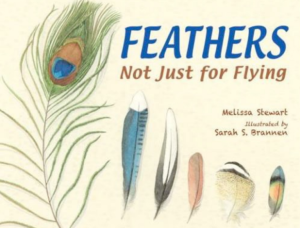
In expository texts, the purpose is to explain. As such, expository text structures are used to present information or to describe phenomena (See Berman & Katzenberger, 2004; Caswell & Duke, 1998). More commonly called “information books” or “nonfiction,” the authors and illustrators of these books explicate a topic (Figure 13.1). Informational books are defined as those written to present, organize, clarify, and interpret documentable, factual material (ALA, nd, Sibert Medal). The “presentation” of factual material can take many forms and this is where the writer’s skill comes into play. For example, in the Family Romanov: Murder, Rebellion, and the Fall of Imperial Russia, Candace Fleming writes the story of one family, weaving together different chains of events while also using maps, charts, definitions, and primary source documents to substantiate her points and to contextualize the circumstances and resulting actions.
Listen to Text Messages Episode 79, A Conversation with Candace Fleming, 2014, as Candace discusses historical story telling and her research process.
Good nonfiction writers use engaging writing techniques to capture the audience’s attention. For example, Vicki Cobb uses real life examples and directly asks readers to think through problems in her nonfiction text, I Face the Wind by Vicki Cobb and illustrated by Julia Gorton, 2003, New York, NY: HarperCollins Publishers.
Relevant Topics and Professional Interests
Think about your college major, your current professional position, or your future aspirations. Are you in health sciences, social work, business, art, engineering, hospitality? What are your professional interests?
Find two children’s information books that relate to your profession. Yes, that’s right—a children’s book. The content of nonfiction children’s literature spans all disciplines.
Find award-winning nonfiction books categorized by discipline:
- History: http://www.ncte.org/library/NCTEFiles/About/Awards/OPBooks-Historical.pdf
- Science: http://www.ncte.org/library/NCTEFiles/About/Awards/OPBooks-Science.pdf
- Biography: http://www.ncte.org/library/NCTEFiles/About/Awards/OPBooks-Biographical.pdf
For example, if your career is in English, language, or linguistics maybe these books are right for you?
- The Right Word: Roget and His Thesaurus written by Jen Bryant and illustrated by Melissa Sweet, 2014, New York, NY: Eerdmans.
- Sequoyah: The Cherokee Man Who Gave his People Writing by James Rumford and translated by Anna Sixkiller Huckaby. (Figure 13.2).

If your career is in fashion, marketing, art direction, or performance, check out the following:
- Balloons Over Broadway written and illustrated by Melissa Sweet, 2011, New York, NY: HMH Books for Young Readers.
- My Story, My Dance: Robert Battle’s Journey to Alvin Ailey by Lesa Cline-Ransome, illustrated byJames E. Ransome. (Figure 13.3).

If your career aspirations are in business, politics,or economics, look for books on related topics.
- Growing Money: A Complete Investing Guide for Kids written by Gail Karlitz and Debbie Honig, 2010, New York, NY: Price Stern Sloan.
- So You Want to be President written by Judith St.George and illustrated by David Small, 2004/2012, New York, NY: Philomel (Figure 13.4).

Figure 13.4. If you like quirky facts about the Presidency and the Presidents of the US, this book is for you. So You Want to be President written by Judith St. George and illustrated by David Small, 2004/2012, New York, NY: Philomel. Illustration copyright 2004/2012 by David Small.
Or, do you just love numbers and math? Read about number people and math problems.
- Money Madness by David A. Adler and illustrated by Edward Miller, 2010, New York, NY: Holiday House.
- Mystery Math: A First Book of Algebra written by David A. Adler and illustrated by Edward Miller. (Figure 13.5).

Focused on law, civil rights, and cultures? Read about others like you.
- Funny Bones: Posada and His Day of the Dead Calaveras by Duncan Tonatiuh. (Figure 13.6).
- Drowned City: Hurricane Katrina & New Orleans written by Don Brown, 2015, New York, NY: HMH Books for Young Readers.
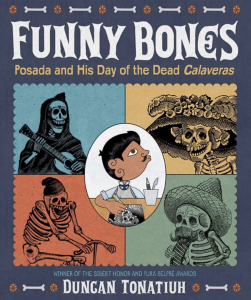
Perhaps you are an historian or your career is in the military.
- Bomb: The Race to Build—and Steal—the World’s Most Dangerous Weapon written by Steve Sheinkin. (Figure 13.7).
- Hitler Youth: Growing Up in Hitler’s Shadow written by Susan Campbell Bartoletti, 2005, New York, NY: Scholastic.

Are you an environmentalist or scientist? Look for books that address your issues and concerns.
- The Elephant Scientist by Caitlin O’Connell and Donna M. Jackson/photographs by Caitlin O’Connell and Timothy Rodwell, 2011, New York, NY: HMH Books for Young Readers.
- Kakapo Rescue: Saving the World’s Strangest Parrot, written by Sy Montgomery, photographs by Nic Bishop (Figure 13.8).

Your Personal Interests and Passions
I’m sure you expected children’s books to cover “school” topics, but what about your personal interests and hobbies? Children’s literature spans a range of topics of interest to many different audiences. Are you into sports, drama, religion, charity work? Find children’s information books that relate to your personal interests and passions.
If you like to fish, check out animals of the sea.
- Neighborhood Sharks: Hunting with the Great Whites of California’s Farallon Islands by Katherine Roy (Figure 13.9).
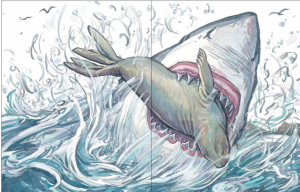
Figure 13.9. Roy writes about sharks with great expertise and in simple terms. Neighborhood Sharks: Hunting with the Great Whites of California’s Farallon Islands by Katherine Roy, 2014, New York, NY: David Macaulay Books. Copyright 2014 by Katherine Roy.
If you enjoy traveling and learning about different people, places, and times, there are plenty of books for you.
- The Grand Mosque of Paris: A Story of How Muslims Rescued Jews during the Holocaust by Karen Gray Ruelle and Deborah Durland Desaix (Figure 13.10).
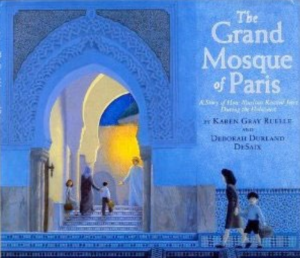
If you love birdwatching, there are many amazing options.
- Look Up! Bird-Watching in Your Own Backyard by Annette LeBlanc Cate (Figure 13.11).
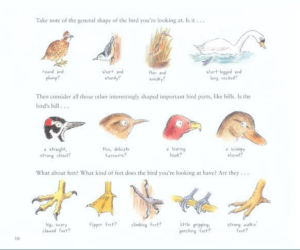
Are you an artist? Read about museums, different media, art installations, or the artists themselves.
- Drawing from Memory by Allen Say (Figure 13.12).

Figure 13.12. Allan Say takes readers on his journey as an illustrator. Drawing from Memory by Allen Say, 2011, New York, NY: Scholastic. Copyright 2011 by Allen Say.
Love the cosmos? Look for books about our constantly evolving universe.
- A Black Hole is NOT a Hole by Carolyn Cinami DeCristofano, illustrated by Michael Carroll (Figure 13.13).
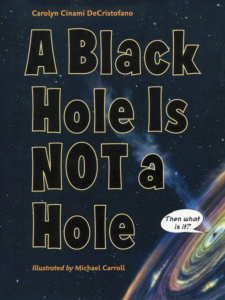
Figure 13.13. Black holes are difficult to understand but this book explains their features with words and images. A Black Hole is NOT a Hole by Carolyn Cinami DeCristofano, illustrated by Michael Carroll, 2012, Boston, MA: Charlesbridge. Cover art copyright 2012 by Michael Carroll.
Do you scrapbook? Yes, there are kids books about scrapbooking.
- The Scraps Book by Lois Ehlert (Figure 13.14).
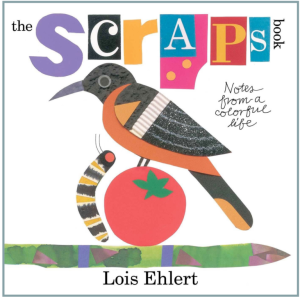
Figure 13.14. Lois Ehlert shares colorful scraps. The Scraps Book by Lois Ehlert, 2014, New York, NY: Beach Lane Books. Copyright 2014 by Lois Ehlert.
Love amusement parks? Look for books that share your interest in roller coasters, cotton candy, and entertainment.
- Mr. Ferris and His Wheel by Kathryn Gibbs Davis and illustrated by Gilbert Ford, 2014, New York, NY: HMH Books for Young Readers (Figure 13.15)
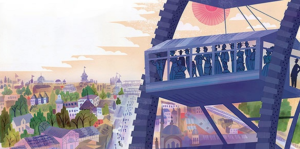
Figure 13.15. Not only does this book provide the history of Mr. Ferris, but the illustrations provide readers with a unique viewing experience of the wheel. Mr. Ferris and His Wheel by Kathryn Gibbs Davis and illustrated by Gilbert Ford, 2014, New York, NY: HMH Books for Young Readers. Illustration copyright 2014 by Gilbert Ford.
If you think children’s books are too simple to add to your knowledge base, think again. Experts across all major fields of study recognize the depth and quality of the content in children’s books. Authors and illustrators consult with experts and conduct extensive research to present accurate information. If a book includes detailed information and advanced knowledge, look at the credits for recognition of the consultants, museums, libraries, and organizations who contributed to the book’s content.
Now that you’ve located books that represent your areas of interest and expertise, what do you notice? Did you learn something new?
Biographies and Autobiographies
Limited Topics and Perspectives in Biographies for Children
The publishing world has produced fabulous examples of nonfiction books for children. Almost every topic is covered, but not every perspective is explored. For example, I love biographies.
I read celebrity biographies (Figure 13.16),

musicians’ biographies (Figure 13.17),
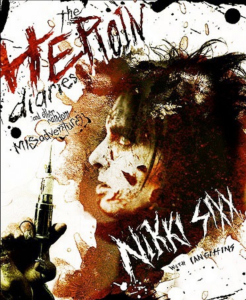
athletes’ biographies (Figure 13.18),
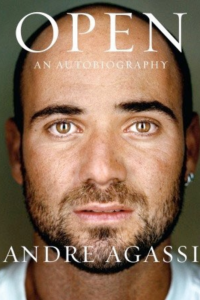
political biographies (Figure 13.19),
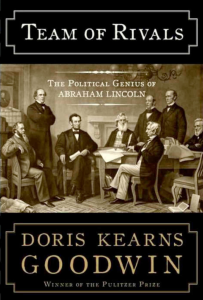
historical biographies (Figure 13.20),
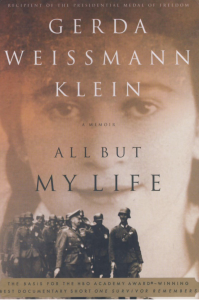
and spiritual biographies (Figure 13.21).

Of course, these examples are not written for children. Yet, when I examine children’s biographies, I see dead people. In fact, I see a lot of dead, white, male people. Where is the children’s equivalent of my Tina Fey or Nikki Sixx?
I am not asking for explicit content, but I am calling for information about interesting people beyond the corporate propaganda for the latest movie release or music album. Certainly a series, such as Who Was?/What Was?, attempts to bridge the gap by featuring a wide array of individuals from the present and the past. But how can an individual’s unique characteristics come through in a book series with formulaic structures and illustrations that look the same? I want to read a biography on Rev. Lennox Yearwood Jr. and the creation of the Hip Hop Caucus (http://www.hiphopcaucus.org/) written by Jacqueline Woodson and illustrated by Chris Raschka (it doesn’t exist, but that’s what I want to read). Or how about a book on the environment that traces the work of Adrianna Quintero, executive director of Voces Verdes (http://www.vocesverdes.org/) and senior attorney at the Natural Resources Defense Council. This book doesn’t exist either. But I want to read it.
I am not alone in seeing dead people, or archaic ideas, reiterated across texts. In a study about gender roles in children’s science biographies, Trevor Owens (2009) determined that Marie Curie and Albert Einstein are the two most frequent subjects of science biographies for children yet they are constructed in gendered ways. He points out that neither of these individuals was from the United States and they are continually portrayed as hating school. He wrote:
Children’s books on Curie have changed in emphasis. Now, instead of simply describing Curie’s accomplishments without context, children’s books have adapted to explain the gender biased world of science and thus demonstrate the further greatness of those accomplishments. Alongside this transition, books on Einstein have begun to offer a much more sympathetic portrayal of Mileva, both as a wife and in most cases as a physicist. Interestingly, the changes in tone in the Curie books began in the late seventies while the change in portrayal of Mileva did not occur until the mid nineties. Despite the increasingly conscious and explicit treatment of gender relations in such children’s books, subtle attitudes towards gender emerge in other contexts, sometimes with much less reformatory potential; in particular, in persistently stereotypical—and gendered—treatments of both Curie’s and Einstein’s relations to authority in school. (Owens, 2009, p. 937)
In the world of children’s literature, portrayals are still gendered and so are the editor’s choices in whose story gets told. For example, by the end of 2015, readers of the Who Was? series could choose from 26 biographies about women (Figure 13.22) and 71 biographies about men (Figure 13.23). In the What Was? series, there were 14 books about topics such as What Was Pompeii? and What Was the Alamo? Of these 14 books, only four books featured a person of color on the cover

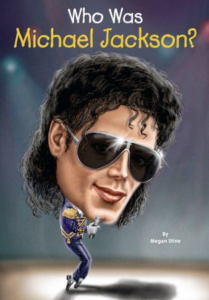
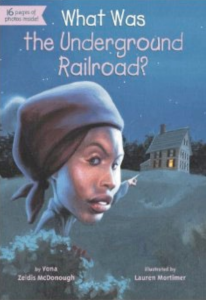
(The March on Washington, The Underground Railroad (Figure 13.24), The Panama Canal, The First Thanksgiving), and four books featured an image of a woman on the cover (The Underground Railroad, Pompeii, Ellis Island, The Statue of Liberty). If this very popular series is any indication of the status of the field, the field is racist and sexist (and other things that I can’t easily see or count). In fact, Thomas Crisp (2015) reviewed the winners of the Orbis Pictus Award for Nonfiction. Using categories of “populations identified frequently as being under-represented and/or marginalized within children’s literature” (p. 244), he found deficits in portrayals of sexual identities, religions, ages, and regions of the world. For those who think race, gender, sexual, economic, and social inequality is solved. Think again.
Children are not vacuous. Children need nonfiction books that address their issues and the concerns of their generation—the environment, Internet safety, bullying. All youth, boys and girls, need to read about the women who shaped history and science. We all need to know about important contributions from people of color.
To explore some of the better examples of contemporary biographies (even though most of the people are still dead), I have selected a range of books highlighting different approaches.
Choose ONE from the following:
- Amelia and Eleanor Go For a Ride by Pam Munoz Ryan and illustrated by Brian Selznick (Figure 13.25).

Figure 13.25. On their own, Amelia and Eleanor are immensely important. Together, they are unstoppable trailblazers. Amelia and Eleanor Go For a Ride by Pam Munoz Ryan and illustrated by Brian Selznick, 1999, New York, NY: Scholastic. Cover art copyright 1999 by Brian Selznick.
- The Watcher: Jane Goodall’s Life with the Chimps by Jeanette Winter (Figure 13.26).
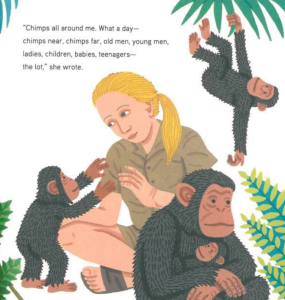
Figure 13.26. Jane Goodall is an amazing scientist and conservationist. The Watcher: Jane Goodall’s Life with the Chimps by Jeanette Winter, 2011, New York, NY: Schwartz and Wade. Copyright 2011 by Jeanette Winter.
- Harlem’s Little Blackbird by Renee Watson (Figure 13.27).
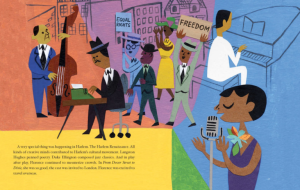
- Wilma Unlimited: How Wilma Rudolph Became the Fastest Woman by Kathleen Krull and illustrated by David Diaz (Figure 13.28).

Figure 13.28. From braces to winning races. Women are sports heroes too. Wilma Unlimited: How Wilma Rudolph Became the Fastest Woman by Kathleen Krull and illustrated by David Diaz, 2000, New York, NY: HMH Books for Young Readers. Cover art copyright 2000 by David Diaz.
- Here Come the Girl Scouts!: The Amazing All True Story of Juliette ‘Daisy’ Gordon Low and Her Great Adventure by Shana Corey and illustrated by Hadley Hooper (Figure 13.29).
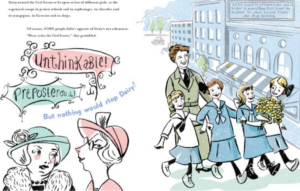
Figure 13.29. How many people know about the origins of the girl scouts? Here Come the Girl Scouts!: The Amazing All True Story of Juliette ‘Daisy’ Gordon Low and Her Great Adventure by Shana Corey and illustrated by Hadley Hooper, 2012, New York, NY: Scholastic. Cover art copyright 2012 by Hadley Hooper.
- Almost Astronauts: 13 Women Who Dared to Dream written by Tanya Lee Stone (Figure 13.30).

Figure 13.30. This collection of stories features brave women who changed the space industry. Almost Astronauts: 13 Women Who Dared to Dream written by Tanya Lee Stone, 2009, Somerville, MA: Candlewick. Cover art copyright 2009 by Tanya Lee Stone.
Choose ONE from the following:
- Nelson Mandela by Kadir Nelson (Figure 13.31).
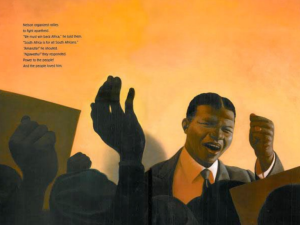
Figure 13.31. He never lost hope. Nelson Mandela by Kadir Nelson, 2013, New York, NY: Katherine Tegen Books. Copyright 2013 by Kadir Nelson.
- Hanging Off Jefferson’s Nose: Growing Up on Mount Rushmore by Tina Coury and illustrated by Sally Wern Comport (Figure 13.32).
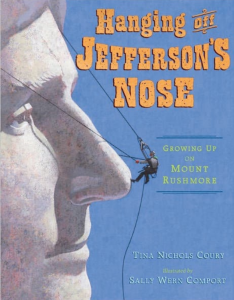
- Jim Henson: The Guy Who Played with Puppets by Kathleen Krull and illustrated by Steve Johnson and Lou Fancher (Figure 13.33).
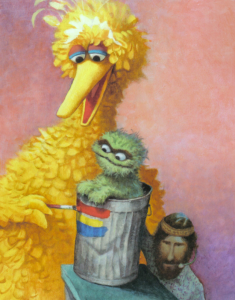
Figure 13.33. He created characters that millions of people have loved for decades. Jim Henson: The Guy Who Played with Puppets by Kathleen Krull and illustrated by Steve Johnson and Lou Fancher, 2011, New York, NY: Random House. Cover art copyright 2011 by Steve Johnson. - Lou Gehrig by David A. Adler and illustrated by Terry Widener (Figure 13.34).
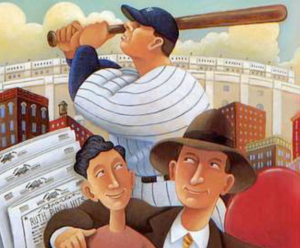
Figure 13.34. David Adler tells Lou Gehrig’s story from his childhood to his becoming the luckiest man on the face of the Earth. Lou Gehrig by David A. Adler and illustrated by Terry Widener, 2001, New York, NY: HMH Books for Young Readers. Cover art copyright 2001 by Terry Widener. Figure 11.33. David Adler tells Lou Gehrig’s story from his childhood to his becoming the luckiest man on the face of the Earth. Lou Gehrig by David A. Adler and illustrated by Terry Widener, 2001, New York, NY: HMH Books for Young Readers. Cover art copyright 2001 by Terry Widener. - It Jes’ Happened: When Bill Traylor Started to Draw by Don Tate and illustrated by R. Gregory Christie (Figure 13.35).

Figure 13.35. Here is a story of untapped talent. It Jes’ Happened: When Bill Traylor Started to Draw by Don Tate and illustrated by R. Gregory Christie, 2012, New York, NY: Lee & Low. Cover art copyright 2012 by R. Gregory Christie. - Freedom Riders: John Lewis and Jim Zwerg on the Front Lines of the Civil Rights Movement by Ann Bausum (Figure 13.36).

Figure 13.36. The Freedom Riders exhibited extraordinary bravery and changed the world. Freedom Riders: John Lewis and Jim Zwerg on the Front Lines of the Civil Rights Movement by Ann Bausum, 2005, Washington, D.C.: National Geographic Books. Copyright 2005 by Ann Bausum.
- How are the individuals portrayed?
- Pay attention to the language in the two books you selected. Do you notice differences and similarities in how the main character is described?
- Compare the content of both books. Do you notice any differences or similarities in the topics covered? What events are highlighted?
- What personal strengths or challenges are featured?
- How did the illustrations affect your reading?
- How did the illustrator’s choices impact your view and understanding of each person?
I am Malala: how one girl stood up for education and changed the world by Malala Yousafzai and Particia McCormick. Who is Malala Yousafzai by Dinah Brown and Andrew Thomson. Marcel Marceau: Master of Mime by Gloria Spielman and Manon Gauthier. Monsieur Marceau: Actor Without Words by Leda Schubert and Gerard DuBois.
Do biographies for children/youth have to be about a famous person’s childhood? No. My daughter watched an episode of Cosmos in which Clair Patterson was featured (http://natgeotv.com/uk/cosmos-a-spacetime-odyssey/videos). Clair Patterson was the man who fought big oil and big research to expose the high concentrations of lead in gasoline and its impact on the environment. Cosmos did not highlight Clair’s childhood; they told the story of his work, his science, and the politics of truth. Based on their portrayal, my daughter selected Clair Patterson as the person for her National History Day project.
Do biographies for children/youth have to censor the information and focus on positive experiences? No. Contemporary biographies are showing signs of wrestling with difficult issues and tragic experiences. Many books have been written about the Holocaust. Fewer books have been written about history since World War II. Shouldn’t children and youth know more about Vietnam, Watergate, or 9/11? Perhaps these topics are too big and complicated? Maybe they are too new? Well, take a look at Hitler Youth: Growing Up in Hitler’s Shadow by Susan Campbell Bartoletti (2005) and you will see an example of how to focus on parts of a complex situation.
Do biographies and nonfiction texts have to focus on serious issues? No. Youth like to read about topics that are relevant to their lives. Sometimes kids want to know who invented Cheetos. Heck, I want to know who invented Cheetos. We know who invented the lightbulb, but who were the people (women and men) who invented the smartphone the iPad, Space Invaders, Super Mario, or Call of Duty?
Biographies and other forms of narrative nonfiction shed light on the past and present. They help us understand events and put them in context of the time. If we all ask for, buy, and check out more interesting biographies and nonfiction books, then more interesting choices will come (Video 13.2).
Video 13.2: Survey of Biography Books https://www.kaltura.com/tiny/njvw5
Expertise and Interesting Writing
Nonfiction writers conduct extensive research and consult with experts, bridging the gap between a field of study and the intended audience of children. In other words, the nonfiction writer is an information translator, recasting details in a different way. Of course, there are always bad examples of nonfiction. But, you might also be surprised by the depth and breadth of what is available.
Author Expertise
Many writers of nonfiction for children have professional backgrounds and training in the area in which they write. Many of them also have careers in teaching and working with children. Below, I’ve highlighted a few individuals.
- Seymour Simon studied Science at the City College of New York. He has a Masters in Comparative Psychology, which is the study of Animal Behavior. He taught middle school science for over 20 years, developing his knowledge of what interests youth and the ways in which children learn about the world (http://www.seymoursimon.com/index.php/about_seymour_simon/faq/)
- David A. Adler graduated from Queens College with a BA in economics and education with licenses to teach mathematics and history. He was a New York City mathematics teacher for nine years. While teaching he earned his MBA in marketing and began a PhD in marketing when he was inspired to write books (http://www.davidaadler.com/bio.htm).
- Susan Campbell Bertoletti has a Bachelors in English and Secondary Education from Marywood University in Scranton, PA. She taught Eighth Grade English (composition, grammar, and literature) for 18 years. She has a Masters in English from the University of Scranton where she also taught courses in composition. She earned a Ph.D. in English from Binghamton University, State University of New York with a creative nonfiction dissertation (Black Potatoes: The Story of the Great Irish Famine, 1845 to 1850. (Published by Houghton Mifflin). She taught courses in creative writing at the college level (http://www.scbartoletti.com/downloads/CV_2010.pdf).
- Vicki Cobb graduated from Barnard College with a major in zoology and a Master’s degree in Secondary Science Education. After an early career as a laboratory researcher, she eventually worked as a science teacher, and then she became a full-time writer of science books for children (http://www.vickicobb.com/aboutvicki.html).
I selected these four award-winning, nonfiction writers because I personally value their work. I am especially impressed with their depth of research, their perspectives on the topics on which they write, their abilities to write for the targeted age level, and their literary styles. As these selected individuals demonstrate, nonfiction writers have personal expertise in the subjects about which they write, and if they don’t have formal training, they have the education and advanced skills necessary to conduct research. As Seymour Simon wrote,
Whenever I want to write about a subject, I need to study. I start by looking at research that other people have done. What experiments have they run? What animals have they observed? By studying all the work that others have already done, I learn about the subjects that I write about in my books. As the great scientist Sir Isaac Newton once wrote, ‘If I have seen further than others, it is because I have stood on the shoulders of giants’ (http://www.seymoursimon.com/index.php/about_seymour_simon/faq/).
It is not a coincidence that each of these successful writers was also a teacher. I didn’t select these individuals because they were teachers, but I believe their extraordinary success in writing for children is a direct result of years of talking with, listening to, and learning from children and youth. As teachers, they learned how to help students access complex disciplinary information by breaking down concepts, modeling ways of thinking, and using writing across the disciplines as a method of communication. They also honor children as intelligent, thoughtful individuals who appreciate accurate information that is written in respectful and interesting ways.
Language Features and Readability
There is an art to writing interesting nonfiction. When presenting information, an author needs to engage the reader while also explaining the content with detail and accuracy. Some authors err on the side of entertainment. For example, when describing how blood flows through the body, an author might animate the blood cells and portray them as talking to one another (Figure 13.37).
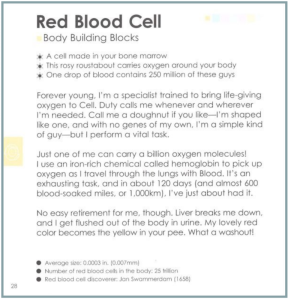
Criteria to evaluate information book:
- Interesting and timely subject matter
- Excellent, engaging, and distinctive use of language
- Excellent, engaging, and distinctive use of visual in illustrated texts (for picturebooks see below)
- Appropriate organization with clear sequencing and logical development
- Thorough documentation and author’s qualifications
- Clear, accurate, and stimulating presentation of facts, concepts, and ideas
- Appropriate style of presentation for subject and for intended audience
- Supportive features (index, table of contents, maps, timelines, etc); respectful and of interest to intended audience
Although anthropomorphism and personification appear to add character and interest to nonfiction topics, they are authorial techniques for fictional storytelling. If the purpose of the text is to present information, then the author should use effective nonfiction techniques while maintaining accuracy and authentic information.
Anthropomorphism is the attribution of human form or other characteristics to beings other than humans, particularly deities and animals. People attribute human-like mental states, for example, to God and non-human animals.
Personification is the related attribution of human form and characteristics to abstract concepts such as nations and natural forces such as the seasons and the weather.
Both anthropomorphism and personification have ancient roots as storytelling and artistic devices. Most cultures have traditional fables with anthropomorphism animals as characters.
Here is a short list of nonfiction techniques: http://www.fionabayrock.com/ARTICLEeleventips.htm

Some information should be narrated. In these instances, there is a dual purpose: to present information and narrate a series of events. Seymour Simon wrote, “I write stories for children that happen to be non-fiction. I don’t write textbooks, or encyclopedias, I’m telling stories” (http://www.seymoursimon.com/index.php/about_seymour_simon/faq/). In the technical sense, Seymour Simon does not tell stories (plot, setting, characters), but he does use narration and argumentation to present information.
The content of nonfiction texts is expansive. With so much to cover, authors may use different formats and text structures to highlight information, isolate important ideas, and make connections across the text. The author’s use of text features can help the reader locate information and make sense of the content. Text features include headings and subheadings, captions, diagrams, labels, text boxes, images, indexes, glossaries, and key words (Figure 13.38). Although these features are used in children’s books, many readers skip over text boxes, diagrams and other features that assist comprehension. Children, youth, and many adults need guidance to understand how the text features work to help them understand the information in a book.
Reading aloud nonfiction text is extremely important. Children need to develop an ear for nonfiction as well as for story and poetry.
- Jennifer Wharton, a blogger for the Children’s and Young Adult Bloggers’ Literary Awards has compiled a list of nonfiction read aloud books: http://www.cybils.com/2015/02/list-fun-read-aloud-non-fiction.html
- Many public librarians have developed helpful lists and suggestions for nonfiction reading: http://www.aadl.org/user/lists/61527
- Pinterest also includes several lists for nonfiction read alouds: https://www.goodreads.com/shelf/show/non-fiction-read-aloud
Children and youth enjoy reading nonfiction books, but they are often dissuaded by teachers who tend to prefer fictional texts. Children typically receive very little time to read nonfiction in school. In fact, in 2000, Nell Duke made the literacy world stand up and take notice of the paucity of attention given to nonfiction texts. In a study of 20 first-grade classrooms, Duke found that children spent an average of 3.6 minutes per day with informational texts during classroom written language activities. This study initiated a series of follow-up studies and additional attention to the role of nonfiction texts in schools. More recently, the Common Core State Standards (National Association of Governors, 2014) have emphasized the reading of nonfiction text, given that most college and career paths require extensive nonfiction reading.
In addition to more reading time, teachers, librarians, and parents should read aloud nonfiction texts. Reading aloud gives the reader an “ear” for nonfiction and explicit instruction provides direct information about the strategies to use (Video 13.3).
If you select the right book, the reading is easy. If not, the reading is snoozy. Pay attention to the language choices in the following excerpts from different books about wind.
I Face The Wind by Vicki Cobb, illustrated by Julia Gorton (2003)
Ever face a strong wind?
Your hair blows away from your face.
You could lose your hat.
And if the wind is blowing hard enough, you may even have to walk at a slant.
You can’t see this force that’s pushing you. But you can feel it. And you can see what wind does to other things.
It makes dust swirl in a circle.
It makes flags stick out straight and flutter.
Can you name some things you see wind do?
Go outside and watch.
Leaves on trees shake.
A kite stays in the sky…
Wind by Marion Dane Bauer, illustrated by John Wallace (2003)
The earth we live on is a spinning ball.
When the earth spins, the air around it moves too.
When air moves we call it “wind.”
As the sun heats the air, the air grows lighter. Light air rises.
Cool air is heavy. It falls…
Wind Energy Engineering by Pramod Jain (2010, p. 9-10)
The energy of wind has been exploited for thousands of years. The oldest applications of wind energy include extracting water from wells, making flour out of grain, and other agricultural applications. In recent times, the use of wind energy has evolved to, primarily, generation of electricity (p. 1) … The kinetic energy contained in wind is:
E = ½ mv2 where m is mass and v is speed; units of energy are kg m2/s2 = Joule.
The mass (m) from which energy is extracted is the mass contained in the volume of air that will flow through the rotor.
The Importance of Illustration
As you might imagine, illustrations play a central role in nonfiction texts for youth. Even the most dense nonfiction narratives will include some photographs and illustrations. For example, look at the examples of the books about wind. In each book, the illustrations play a different role.
In Vicki Cobb’s book, the images help the reader think about the words she wrote. They guide the reader to pay attention to the examples in their own world (Figure 13.39).
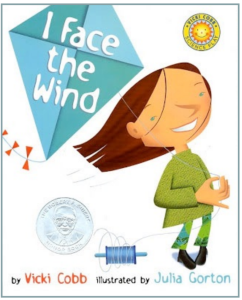
In Marion Dane Bauer’s book, the images add interest to the text, but they do not necessarily add informational content (Figure 13.40).

In Pramod Jain’s book, the images are selected to illustrate concepts that require visualization. For example, how is a turbine constructed? In this case, it’s easier to show the visual than describe or inform through text. The illustrations take the place of needless technical writing (Figure 13.41).

Unlike a young adult novel, the purpose of a nonfiction text is to share information. Therefore, photographs, drawings, illustrations and other forms of media are useful in presenting the information across various modes.
With informational texts, the same standards for artistic quality apply as for any picture book. Illustrated nonfictional texts are similar to, but different from, illustrated fiction.
If the information is presented in the form of a picture book, I use the following criteria from the Caldecott Medal (ALA) to determine the book’s quality.
- Excellence of execution in the artistic technique employed;
- Excellence of pictorial interpretation of theme or concept;
- Appropriateness of style of illustration to the theme or concept;
- Delineation of information through the pictures; excellence of presentation in recognition of the intended audience.
Video 13.4: Survey of Information Book Illustration https://www.kaltura.com/tiny/noij4
Looking Past Dead Presidents and the Same Ol’ Inventors
Good examples of nonfiction are written about all aspects of disciplinary content—from the microscopic (atom) to the enormous (universe). Good examples of nonfiction are also written about all kinds of people who have contributed to society across time periods and across the globe. Modern, effective writers and illustrators accurately inform readers through beautiful language and detailed illustrations. But there is work to do. Nonfiction books continue to feature a lot of dead white people involved in lifeless events that have little relevance to youth. We need to choose nonfiction books carefully and demand excellence and diversity in the coverage of topics for children.
Books
- Winter, J. (2011). The watcher: Jane Goodall’s life with the chimps. Schwartz & Wade.
- Brown, D. (2004). Odd boy out: Young Albert Einstein. Houghton Mifflin Company.
- Rusch, E. (2013). Electrical wizard: How Nikola Tesla lit up the world. Candlewick Press.
- Martin, J. B. (1998). Snowflake Bentley. Houghton Mifflin.
- Shetterly, M. L. (with Conkling, W.). (2018). Hidden figures: The true story of four Black women and the space race. Harper.
- Mosca, J. F. (2017). The girl who thought in pictures: The story of Dr. Temple Grandin. The Innovation Press.
- Engle, M. (2019). Dancing hands: How Teresa Carreño played the piano for President Lincoln. Atheneum Books for Young Readers.
- Morales, Y. (2014). Viva Frida. Roaring Brook Press.
- Winter, J. (2013). Henri’s scissors. Beach Lane Books.
- Ryan, P. M. (2002). When Marian sang: The true recital of Marian Anderson. Scholastic Press.
- Pinkney, A. D. (1998). Duke Ellington: The piano prince and his orchestra. Hyperion Books for Children.
- Winter, J. (2014). Mr. Cornell’s dream boxes. Beach Lane Books.
- Giovanni, N. (2005). Rosa. Square Fish.
- D’Aulaire, I., & D’Aulaire, E. P. (1946). Pocahontas. Beautiful Feet Books.
- Rappaport, D. (2001). Martin’s big words: The life of Dr. Martin Luther King Jr. Little, Brown Books for Young Readers.
- Weatherford, C. B. (2015). Voice of freedom: Fannie Lou Hamer. Candlewick Press.
- Cooney, B. (1996). Eleanor. Puffin Books.
- Bendick, J. (1999). Along came Galileo. Beautiful Feet Books.
- Stone, T. L. (2008). Elizabeth leads the way. Henry Holt and Company.
- Krull, K. (2004). The boy on Fairfield Street: How Ted Geisel grew up to become Dr. Seuss. Random House.
- Markel, M. (2017). Balderdash!: John Newbery and the boisterous birth of children’s books. Chronicle Books.
- Yousafzai, M. (2017). Malala’s magic pencil. Little, Brown and Company.
- Gerstein, M. (2003). The man who walked between the towers. Square Fish.
- Hubbard, R. L. (2020). The oldest student: How Mary Walker learned to read. Schwartz & Wade.
- Churnin, N. (2018). Charlie takes his shot: How Charlie Sifford broke the color barrier in golf. Albert Whitman & Company.
- Churnin, N. (2016). The William Hoy story: How a deaf baseball player changed the game. Albert Whitman & Company.
Additional Information
Virginia Commonwealth University students in a children’s literature class read a picture book biography and created an accompanying set of clues about the individual: Who Am I? The purpose of this activity is to generate interest in reading other picture book biographies and could be adapted for elementary students to share their research and information learned from reading the biography. See examples below.

Who am I?
In 1921 I left my home in Puerto Rico to go visit New York.
My visit turned into me staying in New York and my first job was in a garment factory.
I speak Spanish, English, and French.
I then got a job at a library that needed a bilingual assistant.
I noticed that there were no books or stories in the library from or about Puerto Rico.
I started telling stories to children in the library and soon after I made puppets to go along with my stories that were in English and Spanish.
I typed and mailed my story to a publisher and my story Perez y Martina became a book.
I wrote, learned, spoke, taught, and traveled after my book was published.
I married musician Clarence Cameron White and left my job to tour with my husband and focus on my writing.
In 1961, after my husband passed, I returned to the library and noticed that people were reading my books to the children.
I then realized that the seeds I planted as a Latina writer and librarian grew into a beautiful landscape.
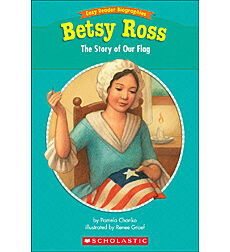
Who am I?
I was born in Philadelphia, Pennsylvania on January 1, 1752.
I had sixteen brothers and sisters.
I made clothes for the whole family and was very good at it.
I was lucky enough to go to school.
I worked at a shop and sewed bedspreads.
I was one of the best at sewing and opened my own shop.
I sewed clothes for soldiers to make extra money.
I was asked to make a flag of the new colonies.
My flags hung on the ships that fought the revolution.
My flag became the flag of the new United States.
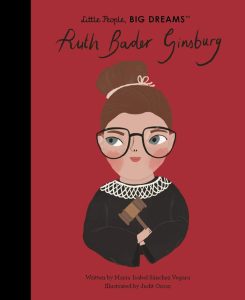
Who Am I?
I was a Jewish girl raised in New York
My mother taught me to be a strong, independent woman, like herself
When she died, I promised to do all she would for gender equality in our country
I studied the 14th amendment extensively
I became the leader of a feminist law group at the university I taught at
I won hundreds of cases
My hard work against gender discrimination landed me on the supreme court
I was only the 2nd woman who had this opportunity
Though my passion was in women’s rights, I fought for the equality of all!
Even when I didn’t win, I won the hearts of young people all around
I believe equality starts by making fair and equal laws, and I inspired many women to follow in my footsteps

Who am I?
I was born in Poland.
I moved to France to attend college, since women were not allowed to go to college in Poland.
I became a scholar in math and science.
While in France, I met and married another scientist, Pierre.
Pierre and I worked in a laboratory together where we discovered radium and polonium.
We won a Nobel Prize for our research. I was the first woman to receive the Nobel Prize!
Then, my husband died. But I was determined to keep working!
My research earned me a second Nobel Prize!
My discoveries were used to help injured soldiers during wars and I inspired many young girls.
I taught my students to learn as much as they can and to help people in need.
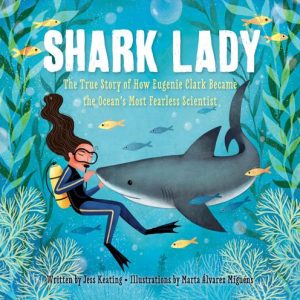
Who am I?
I spent my childhood in the New York Aquarium.
I conducted 72 submersible dives and many more using Scuba gear.
I explored places underwater that no one else had at the time.
I spend much of my adult life teaching people about sharks.
I rode on the back of a 50-foot whale shark.
I changed the way we see sharks.
I completed my last dive at 92 years old, a year before I died.
I am the shark lady.
Additional Resources
References
- Figure 13.1. Feather Not Just for Flying by Melissa Stewart and illustrated by Sarah S. Brannen, 2014, Watertown, MA: Charlesbridge Publishing. Cover art copyright 2014 by Sarah S. Brannen.
- Figure 13.2. Sequoyah: The Cherokee Man Who Gave his People Writing by James Rumford and translated by Anna Sixkiller Huckaby, 2002, New York, NY: HMH Books for Young Readers. Cover image copyright 2004 by Anna Sixkiller Huckaby.
- Figure 13.3. My Story, My Dance: Robert Battle’s Journey to Alvin Ailey by Lesa Cline-Ransome, illustrated by James E. Ransome, 2015, New York, NY: Simon & Schuster. Illustration copyright 2015 by James E. Ransome.
- Figure 13.4. So You Want to be President written by Judith St. George and illustrated by David Small, 2004/2012, New York, NY: Philomel. Illustration copyright 2004/2012 by David Small.
- Figure 13.5. Mystery Math: A First Book of Algebra written by David A. Adler and illustrated by Edward Miller, 2011, New York, NY: Holiday House. Cover Art copyright 2011 by Edward Miller.
- Figure 13.6. Funny Bones: Posada and His Day of the Dead Calaveras by Duncan Tonatiuh, 2015, New York, NY: Harry N. Abrams. Copyright 2015 by Duncan Tonatiuh.
- Figure 13.7. Bomb: The Race to Build-and Steal-the World’s Most Dangerous Weapon written by Steve Sheinkin, 2012, New York, NY: Flash Point. Copyright 2012 by Steve Sheinkin.
- Figure 13.8. Kakapo Rescue: Saving the World’s Strangest Parrot, written by Sy Montgomery, photographs by Nic Bishop, 2010, New York, NY: Houghton Mifflin Books for Children. Cover art copyright 2012 by Nic Bishop.
- Figure 13.9. Neighborhood Sharks: Hunting with the Great Whites of California’s Farallon Islands by Katherine Roy, 2014, New York, NY: David Macaulay Books. Copyright 2014 by Katherine Roy.
- Figure 13.10. The Grand Mosque of Paris: A Story of How Muslims Rescued Jews during the Holocaust by Karen Gray Ruelle and Deborah Durland Desaix, 2009, New York, NY: Holiday House. Cover art copyright 2009 by Deborah Durland Desaix.
- Figure 13.11. Look Up! Bird-Watching in Your Own Backyard by Annette LeBlanc Cate, 2013, Somerville, MA: Candlewick. Copyright 2013 by Annette LeBlanc Cate.
- Figure 13.12. Drawing from Memory by Allen Say, 2011, New York, NY: Scholastic. Copyright 2011 by Allen Say.
- Figure 13.13. A Black Hole is NOT a Hole by Carolyn Cinami DeCristofano, illustrated by Michael Carroll, 2012, Boston, MA: Charlesbridge. Cover art copyright 2012 by Michael Carroll
- Figure 13.14. The Scraps Book by Lois Ehlert, 2014, New York, NY: Beach Lane Books. Copyright 2014 by Lois Ehlert.
- Figure 13.15. Mr. Ferris and His Wheel by Kathryn Gibbs Davis and illustrated by Gilbert Ford, 2014, New York, NY: HMH Books for Young Readers. Illustration copyright 2014 by Gilbert Ford.
- Figure 13.16. Bossypants by Tina Fey, 2014, Boston, MA: Back Bay Books. Copyright 2014 by Tina Fey.
- Figure 13.17. Heroin Diaries by Nikki Sixx and Ian Gittins, 2007, New York, NY: Pocket Books. Copyright 2007 by Nikki Sixx and Ian Gittins.
- Figure 13.18. Open by Andre Agassi, 2009, New York, NY: Knopf. Copyright 2009 by Andre Agassi.
- Figure 13.19. Team of Rivals: The Political Genius of Abraham Lincoln by Doris Kearns Goodwin, 2006, New York, NY: Simon & Schuster. Copyright 2006 by Doris Kearns Goodwin.
- Figure 13.20. All But My Life: A Memoir by Gerda Weissman Klein, 1995, New York, NY: Hill and Wang. Copyright 1995 by Gerda Weissman Klein.
- Figure 13.21. The Story of My Experiments with Truth: An Autobiography by Mohandas Karamchand (Mahatma) Gandhi, 2014, Seattle WA: CreateSpace. Copyright 2014 by Mohandas Karamchand (Mahatma) Gandhi.
- Figure 13.22. Who is Malala Yousafzai? By Dinah Brown and illustrated by Andrew Thomson, 2015, New York, NY: Grosset & Dunlap. Cover art copyright 2015 by Andrew Thomson.
- Figure 13.23. Who was Michael Jackson? By Megan Stine and illustrated by Joseph J.M. Qiu, 2015, New York, NY: Grosset & Dunlap. Cover art copyright 2015 by Joseph J.M. Qiu.
- Figure 13.24. What was the Underground Railroad? By Yona Zeldis McDonough and illustrated by Lauren Mortimer and James Bennett, 2013, New York, NY: Grosset & Dunlap. Cover art copyright 2013 by Lauren Mortimer and James Bennett.
- Figure 13.25. Amelia and Eleanor Go For a Ride by Pam Munoz Ryan and illustrated by Brian Selznick, 1999, New York, NY: Scholastic. Cover art copyright 1999 by Brian Selznick.
- Figure 13.26. The Watcher: Jane Goodall’s Life with the Chimps by Jeanette Winter, 2011, New York, NY: Schwartz and Wade. Copyright 2011 by Jeanette Winter.
- Figure 13.27. Harlem’s Little Blackbird by Renee Watson, 2012, NY: Random House. Copyright 2012 by Renee Watson.
- Figure 13.28. Wilma Unlimited: How Wilma Rudolph Became the Fastest Woman by Kathleen Krull and illustrated by David Diaz, 2000, New York, NY: HMH Books for Young Readers. Cover art copyright 2000 by David Diaz.
- Figure 13.29. Here Come the Girl Scouts!: The Amazing All True Story of Juliette ‘Daisy’ Gordon Low and Her Great Adventure by Shana Corey and illustrated by Hadley Hooper, 2012, New York, NY: Scholastic. Cover art copyright 2012 by Hadley Hooper.
- Figure 13.30. Almost Astronauts: 13 Women Who Dared to Dream written by Tanya Lee Stone, 2009, Somerville, MA: Candlewick. Cover art copyright 2009 by Tanya Lee Stone.
- Figure 13.31. Nelson Mandela by Kadir Nelson, 2013, New York, NY: Katherine Tegen Books. Copyright 2013 by Kadir Nelson.
- Figure 13.32. Hanging Off Jefferson’s Nose: Growing Up on Mount Rushmore by Tina Coury and illustrated by Sally Wern Comport, 2012, New York, NY: Dial. Cover art copyright 2012 by Sally Wen Comport.
- Figure 13.33. Jim Henson: The Guy Who Played with Puppets by Kathleen Krull and illustrated by Steve Johnson and Lou Fancher, 2011, New York, NY: Random House. Cover art copyright 2011 by Steve Johnson.
- Figure 13.34. Lou Gehrig by David A. Adler and illustrated by Terry Widener, 2001, New York, NY: HMH Books for Young Readers. Cover art copyright 2001 by Terry Widener.
- Figure 13.35. It Jes’ Happened: When Bill Traylor Started to Draw by Don Tate and illustrated by R. Gregory Christie, 2012, New York, NY: Lee & Low. Cover art copyright 2012 by R. Gregory Christie.
- Figure 13.36. Freedom Riders: John Lewis and Jim Zwerg on the Front Lines of the Civil Rights Movement by Ann Bausum, 2005, Washington, D.C.: National Geographic Books. Copyright 2005 by Ann Bausum.
- Figure 13.37. Human Body: A Book with Guts! By Dan Green and Simon Basher and illustrated by Simon Basher, 2011, New York, NY: Kingfisher. Text copyright 2011 by Dan Green and Simon Basher.
- Figure 13.38. The Science Book: Big Ideas Simply Explained by Dan Green, 2014, Washington, D.C.: DK Books. Excerpt copyright 2014 by Dan Green.
- Figure 13.39. I Face the Wind by Vicki Cobb and illustrated by Julia Gorton, 2003, New York, NY: HarperCollins. Cover art copyright 2003 by Julia Gorton.
- Figure 13.40. Wind by Marion Dane Bauer and illustrated by John Wallace, 2003, New York, NY: Simon Spotlight. Cover art copyright 2003 by John Wallace.
- Figure 13.40. Wind Energy Engineering by Pramod Jain, 2010, New York, NY: McGraw Hill. Copyright 2010 by Pramod Jain.

